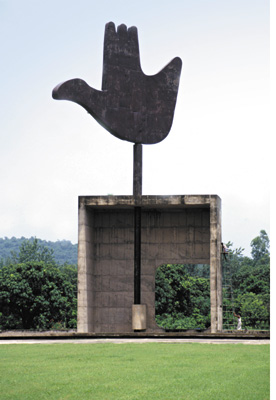
“Le Corbusier has sought to create an architecture of passion in Chandigarh. His buildings-both in concept and visual language-have always been presented at a certain decibel level. No sotto-voce, no politeness but like Wagner-thunder in the concert hall.” This was how legendary architect Charles Correa described Le Corbusier’s design for the city of Chandigarh. He also commented on the irony of how a Swiss-French architect like Corbusier was able to invoke in his seemingly global architecture, “our history..where Chandigarh finds echoes in Fatehpur Sikri, in Jaisalmer, in Mandu. Surely, this is why a building of Corbs’ sits so well on Indian soil.”
The architecture in Chandigarh is indeed a series of flourishes. The buildings are modern but in their shape and intent they serve the city and in their futuristic design, they recall many architectural features from India’s rich architectural past.

Chandigarh was the first planned city in India post independence in 1947 and was commissioned by the first Prime Minister of India Jawaharlal Nehru to encapsulate India’s vision for itself. Nehru chose the French (born Swiss) architect and urban planner, Le Corbusier but he came on board after the blue print was prepared by the American Albert Mayer and Polish-born architect Matthew Nowicki and many ideas from the original master plan were retained. Nowicki had died in a plane crash and Mayer had resigned and it was left then to Le Corbusier to take the ambitious plan forward.The plan clearly demarcates the city according to function (living, working, moving and nourishing the body and spirit), connecting various neighbourhood units, or ‘Sectors’. The Sector is a self-sustaining but well-connected unit with shopping zones, recreation and more.

Vertical green belts liven up the urbanscape joyously. Housing units cater to various economic sections and geometric parks and garden roundels at traffic junctions offer lungspace and aesthetic respite. The city is partly a study in geometric shapes, of rectangles, stark lines and planes and is partly fluid and inclusive. Corbusier who later inspired Correa to use “honest, contextual materials” uses exposed brick extensively, boulder stones, rough concrete surfaces and then there are the sculptures, including the towering open hands that Corbusier associated with an open minded reciprocity and receiving and giving all the good that life has to offer.
That he was man of idealism and just a bit fond of making sentimental gestures is also clear from the Monument to Peace at the waterfront park at Sukhna Lake which proclaims,”Chandigarh, the City of Peace. Let’s strive for: community harmony, cultural diversity, rejection of violence, resolution of conflict, reconciliation of differences, freedom of expression.”

What Corbusier taught not just Correa but us all is that even in a modern urbanscape, there can be a quiver of emotion, the celebration of human-interconnectedness, a subtext of humanism and co-existence and for that reason, he was also called the Spiritual Director” of the entire Chandigarh Capitol Project and also designed many symbolic buildings including the show-stopping ones in the ‘Capitol Parc’ – the ‘head’ of the city against the stunning backdrop of the Shiwalik Hills and and the ones in the city’s ‘heart’, the City Centre. He understood that a city needs to feel as much as it needs to think hence the cultural and leisure zones in the city.
The Capitol Parc is a staggering achievement not just because of its scale and expanse but because it represents what democracy should be at its best. Proud of its grandeur and yet accessible to every citizen.
Chandigarh was Corbusier’s labour of love for over 13 years where he poured himself into every micro and macro details and in the end he created a city that belongs to India’s past and its future, prompting Correa to famously exult that Corbusier just may one day be acknowledged, “as the greatest Indian architect of them all.”
**This piece earlier appeared in the student edition of a newspaper
Reema Moudgil has been writing for magazines and newspapers on art, cinema, issues, architecture and more since 1994, is an RJ, hosts a daily Ghazal show, runs unboxed writers, is the editor of Chicken Soup for The Indian Woman’s soul, the author of Perfect Eight (http://www.flipkart.com/perfect-eight-9380032870/p/itmdf87fpkhszfkb?pid=9789380032870&_l=A0vO9n9FWsBsMJKAKw47rw–&_r=dyRavyz2qKxOF7Yuc ) and an artist.









